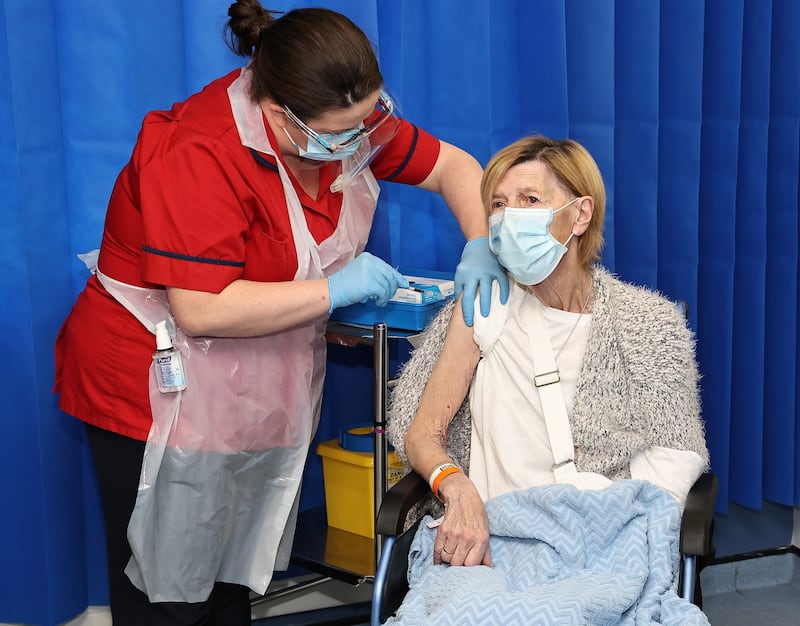It has been over a year since the first case of Covid-19 was confirmed in the Republic of Ireland. Since then, over 300,000 people have been diagnosed in the State, and over 5,000 people have died.
Globally, over 200 million people have been diagnosed and over 4 million have died since the virus was first identified in China in December 2019.
| Total doses distributed to Ireland | Total doses administered in Ireland |
|---|---|
| 12,143,670 | 10,222,511 |
NEWS AND UPDATES:
- How many people have been vaccinated here?
- Almost all Covid-19 restrictions to be lifted by October 22nd
- Covid boosters to be offered to over-12s with weakened immune systems
- New coronavirus strain designated a variant of interest by WHO
Scientists have been racing to develop a vaccine that would bring an end to the pandemic, and there are now 99 different vaccines in clinical development, with another 184 in preclinical development, according to the World Health Organisation.
Four of these have been authorised for use in the EU - one from AstraZeneca, one from BioNTech-Pfizer, one from Moderna and another from Johnson & Johnson (Janssen).
The EU has put in place purchase agreements with Sanofi-GSK and Curevac, and has concluded exploratory talks with two other vaccine producers - Novavax and Valneva.
Ireland, along with all other EU member states, will get a proportional amount of every vaccine that is approved for use by the European Medicines Agency (EMA) according to its population.
Ireland is in line to get 14 million doses of at least five different vaccines during 2021, more than enough to vaccinate the entire country.
But how do these other vaccines work, and when will they be approved for use here? Have there been any reported side effects? And when can you expect to receive a vaccine?
The Irish Times Vaccine Tracker will be updated daily as the country embarks on the largest inoculation programme in the history of the State.
SKIP TO LEADING VACCINES
- BioNTech-Pfizer
- Moderna
- AstraZeneca
- Janssen/J&J
- Novavax
- Sanofi/JSK
- Curevac
- Valneva

Leading vaccines in the pipeline for Ireland

Dose: Two doses, 21-28 days apart.
Storage: Must be kept in a freezer at - 70°C.
Stated efficacy: 95 per cent.
EMA approval: Granted on December 21st.
Overview: Developed by New York-based Pfizer and German company BioNTech this vaccine has a brand name of Comirnaty. It uses messenger RNA (mRNA) technology, which has instructions for producing a protein from Sars-CoV-2, the virus that causes Covid-19. The person's immune system recognises this protein as foreign and produces antibodies and activates T-cells (white blood cells) to attack it, giving them immunity. The vaccine will last for six months when stored at -70C, and five days when stored at between 2 and 8 degrees Celsius. The EU has approved the withdrawal of six doses from each vial.
Side effects: Common side effects (occurring in more than 1 in 10 people) included pain and swelling at the injection site, tiredness, headache, muscle and joint pain, chills and fever. Severe allergic reactions occurred in a very small number of cases.
How many will Ireland get? 546,000 in April, 738,000 in May and 844,000 doses in June, with 5.4 million doses in total expected by the end of 2021.

Dose: Two doses, 28 days apart.
Storage: Must be kept in a freezer at - 20°C.
Stated efficacy: 94.1 per cent.
EMA approval: Granted on January 6th.
Overview: Developed by Boston-based company Moderna, this vaccine is manufactured for EU states at partner plants in Switzerland, France and Spain before being distributed across the continent. Like the Pfizer BioNTech vaccine, it uses mRNA technology to produce a Sars-CoV-2 protein, which the body then attacks to give immunity. It will last for up to six months when stored at - 20°C. The first Moderna vaccine was given in Ireland on January 16th.
Side effects: Common side effects (occurring in more than 1 in 10 people) included pain and swelling at the injection site, tiredness, chills, fever, swollen or tender lymph nodes under the arm, headache, muscle and joint pain, nausea and vomiting. Less common was redness, hives and rash at the injection site. Severe allergic reactions occurred in a very small number of cases.
How many will Ireland get? 383,000 by June and 870,000 doses by the end of 2021.

Dose: Two doses, between 4 and 12 weeks apart
Storage: 2-8 °C.
Stated efficacy: 76-82% according to AstraZeneca, 60% according to the EMA
EMA approval: Granted on January 29th.
Overview: The Oxford/AstraZeneca vaccine (also known as Vaxzevria) was thought of as a potential game-changer because it can be transported and stored at 2 degrees to 8 degrees for up to six months, making it much easier to move around and administer. It is also much cheaper, costing about $3-4 per shot, compared with $20 for the Pfizer/BioNTech jab, with the former being made on a not-for-profit basis for the duration of the pandemic.
It is based on a harmless chimp cold virus that cannot grow inside human cells. Scientists have tweaked this virus so that it carries genetic material containing the instructions for a protein of the coronavirus. Once the vaccine has been administered, our bodies produce the coronavirus protein, triggering an immune response.
During the trial, a dosing error led to the serendipitous finding that when clinical trial participants were given half a dose followed by a full dose, the vaccine had a higher efficacy than when participants were given two full doses, with 90 per cent efficacy in the former case and 62 per cent efficacy in the latter. This led AstraZeneca to announce in November a new global trial of the vaccine with the half dose/full dose regime.
In January, a bitter row broke out between the European Union and AstraZeneca after the pharmaceutical company drastically revised downwards the number of doses it could deliver the bloc.
While the EMA approved the use of this vaccine for all ages, doubt was cast over its efficacy in the over 65s due to the lack of data from Astrazeneca’s clinical trials in this cohort. As a result, Germany, Austria, Sweden, Poland and Belgium have opted not to approve this product for their older population.
Following suit, Ireland has also decided to use the Pfizer or Moderna vaccine for the over 70s where possible, not the AstraZeneca jab.
It would not be the first time this jab led to a significant reorganisation of our vaccination plans.
Reports of serious blood clots, mostly in women aged under 60, led the National Immunisation Advisory Committee (Niac) to first defer the use of the vaccine on March 14th, before resuming it's use on March 20th.
However, on April 12th, Niac recommended that AstraZeneca should not be given to people aged under 60, once again leading to a reorganisation of the rollout. This was revised to people aged over 50 on April 27th. On June 28th, Niac revised its advice again and said the vaccine could be given to people aged under 40, although the mRNA shots were preferable for that age group.
Side-effects: Very rare blood clots found in small number of cases
How many will Ireland get? Latest projections are 224,000 in April, 262,000 in May and 327,000 in June

Dose: One
Storage: Lasts for up to two years frozen at –20° C, and up to three months refrigerated at 2-8° C.
Stated efficacy: 57 - 72 per cent
Trial stage: Phase 3.
EMA approval: Approved on March 11th.
Overview: The EMA started a rolling review of this single dose vaccine from Janssen, the Belgium-based subsidiary of Johnson & Johnson on December 1st.
On January 29th the company announced the results of its Phase 3 trial: the vaccine had an efficacy of 72 per cent in the United States, 66 per cent in Latin America, and 57 per cent in South Africa.
This vaccine uses double-stranded DNA to deliver a protein from the SARS-CoV-2 virus into the body, thereby creating immunity. It is different from others on the market in that it requires just one injection. The EU has agreed an initial contract for 200 million doses, with an option to buy 200 million more.
On February 16th the company applied to the EMA for seeking authorisation for its single-dose vaccine, and it was approved on March 11th.
However, on April 13th the company paused deliveries of its vaccine in Europe pending an investigation of rare blood clot cases that have halted its rollout in the US. The blood clotting conditions reported in recipients of the Johnson & Johnson vaccine in the US are the same rare condition linked to the AstraZeneca vaccine.
On April 20th, the EMA's review of these issues found a possible link to very rare cases of unusual blood clots with low blood platelets, and agreed a warning should be included in the product information.
However, it concluded the overall benefits of the vaccine in preventing Covid-19 outweigh the risks of side effects, and so Janssen announced it would resume deliveries to the EU. In Ireland, Niac initially recommended that the jab be used only for people over the age of 50, but this was revised to include the under 40s on June 28th. Those aged 18-34 can apply to get the Janssen vaccine at pharmacies around the country.
How many will Ireland get? 2.2 million doses in total, 600,000 between April and June.

Dose: Two doses, three weeks apart.
Storage: Stable at 2°C to 8°C.
Stated efficacy: 85 - 95 per cent
EMA approval: Under rolling review.
Trial stage: Phase 3
Overview: US company Novavax has developed a Covid-19 vaccine which stimulates an immune response by delivering spike proteins into the body. These spike-proteins are grown and harvested from insects. Similar technology is used in the production of vaccines for influenza and HPV. The European Commission has concluded exploratory talks with Novavax with a view to purchasing up to 200 million doses. The EMA began a rolling review of the vaccine on February 3rd.

Trial stage: Phase 2b.
Overview: In September the EU signed a deal to purchase 300 million doses of this vaccine. It is based on the same technology as one of Sanofi's seasonal influenza vaccines - more conventional than the mRNA used by Pfizer and Moderna - and it was thought it could play a big role in ending the pandemic. However, despite positive results from Phase 1 trials, news came in December that Phase 2 trial results showed an insufficient immune response in older adults. Phase III studies were expected to start in December, but the companies now plan to begin a phase 2b study in February with a different formulation of the vaccine. Even if their new formulation is successful, they do not expect the vaccine to be available until the end of 2021.

Dose: Two doses, four weeks apart.
Storage: Will last for at least 3 months at 2-8°C.
Stated efficacy: Unknown.
EMA approval: Under rolling review.
Trial stage: Phase 3.
Overview: The German company CureVac began its final Phase 3 trials in December, with results expected in the first quarter of 2021. It uses the same mRNA technology as the Moderna and Pfizer vaccines, but can be kept at normal refrigerator temperatures. The company has signed a deal with the EU to supply 405 million doses, pending regulatory approval.
The EMA began a rolling review of the vaccine on February 12th.

Dose: Two.
Storage: Stable at 2°C to 8°C.
Stated efficacy: Unknown.
EMA approval: Not yet under review.
Trial stage: Phase 1/2.
Overview: Valneva is a French company which has created a Covid-19 vaccine based on their Japanese encephalitis vaccine. It delivers a chemically inactivated coronavirus and uses an adjuvant (immunity booster) to create immunity. It entered clinical trials in December and reported positive results from these initial phase 1 and 2 trial in April 2021, while announcing it was entering phase 3 trials on 4,000 people.
On January 12th the European Commission concluded exploratory talks with the company for the supply of 30 million doses, with the option to buy a further 30 million.

When might you be vaccinated?
Over 80 per cent of people in Ireland aged over 18 are now fully vaccinated, with over 90 per cent in receipt of at least one dose.
Anyone over the age of 12 can now register for a vaccine.
If you have not yet received your vaccine you can visit the HSE site here to register.

















